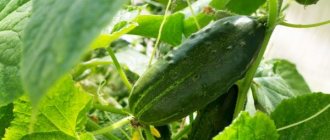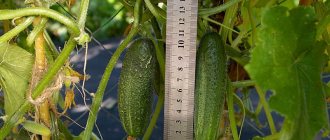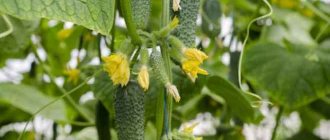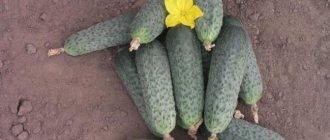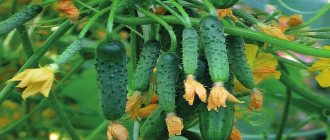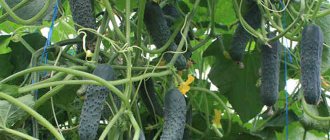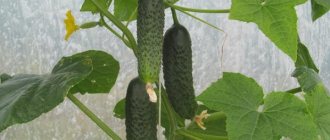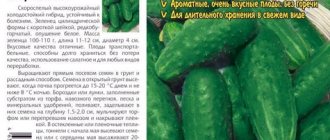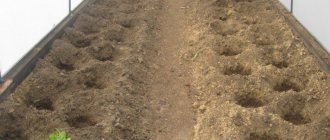Description
The cucumber hybrid Dolomite F1 is parthenocarpic, and therefore does not require pollination by pollinating insects, because the ovaries on its vines are formed without pollination.
What does f1 hybrid and GMO mean, what is the difference?
The main advantage of this cucumber is the ultra-early ripening of the fruits - up to 38 days pass from the moment of seed germination to the appearance of the first cucumbers.
Related article:
How to water cucumbers correctly
Cucumber seeds Dolomite F1
There are no barren flowers on the vines of this cucumber; only female flowers are formed on them, so the productivity of this variety is maintained throughout the entire growing season.
ofazende.ru recommends the Serpentine cucumber variety
The lashes of this variety are strong and powerful, and can reach 1.4-1.6 m in height. The branching of the shoots is moderate, the side stems grow well. The foliage is medium in size, slightly wrinkled, rich emerald color.
The flowers are collected in bunch-type inflorescences, so each bunch can contain from 2 to 8 cucumbers at the same time.
Cucumbers are medium in size, cylindrical in shape, with an average weight of about 100 g, up to 13 cm in length and up to 4 cm in diameter.
The skin of cucumbers is thin, but quite dense and crispy, covered with small tubercles with light, moderate pubescence.
Related article:
When to plant cucumbers for seedlings in 2021, lunar calendar
Cucumber variety Dolomite F1
The pulp is compact, tender, has no voids, and the bitterness in these cucumbers is absent at the genetic level. The taste of ripe greens is typical of cucumbers, with a sweetish aftertaste.
Collected greens can easily be transported over any distance, and can also be stored in appropriate containers for up to two weeks without losing their magnificent appearance and taste.
Agricultural technology: rules, features
Cucumber Dolomite F1 is grown by planting seedlings or seeds in the ground.
- for ground sowing it is necessary to warm the soil to 18 degrees;
- seeds for seedlings are sown 21 - 30 days before moving to the beds;
- up to 4 bushes are planted per 1 m²;
- strengthening is prepared for the plant (mesh or trellis);
- The main stem is pinched at a convenient height or when it reaches the ceiling of the greenhouse;
- Watering is carried out with warm, settled water.
Advice. It is necessary to loosen the soil near the bushes once every 7 days. This measure will speed up fruiting.
Sowing seeds for seedlings | Planting seedlings in a greenhouse/greenhouse | Planting OG seedlings | Stepsoning | Harvesting |
| March, April | After 4 – 5 leaves | Not earlier than the 2nd ten days of May | — | End of June |
| *dates for central Russia | ||||
Main characteristics of the variety
The Dolomite cucumber bears fruit for a long time, and the first fruits can be harvested about a month after the sprouts appear.
Productivity
Cucumbers are usually harvested at the gherkins and pickles stage. Therefore, from each square of garden beds you can collect up to 5 kg of ripe gherkins. And in greenhouse conditions, the yield of the hybrid is even higher.
Related article:
This will help prolong the fruiting of cucumbers in the greenhouse.
Area of application of fruits
The harvested crop has universal uses, so they can be served fresh, added to summer salads, and also used for preservation. Since these cucumbers tolerate heat treatment well, and no voids form in them, the greens look great in jars, and the taste of pickled gherkins remains sweet.
Diseases and pests
This hybrid has a fairly high resistance to MR, root rot, gray mold and fusarium. However, if agricultural practices are incorrect or the rules for planting seeds or seedlings are not followed, cucumber vines can be affected by ascochyta blight and wet rot. Plants can also be attacked by the sprout fly.
Ascochyta blight most often affects cucumber plantings in greenhouse conditions. The causative agent of the disease can safely multiply in the beds without affecting the cucumber vines, and the first symptoms of the disease begin to appear at the moment the cucumbers ripen. The first symptoms of the disease are the appearance of watery spots on green plants; over time they dry out and die.
Related article:
How to deal with aphids on cucumbers
Wet rot can enter the soil along with infected seed material; the disease develops along with the plant and enters the setting fruit. As a result, they begin to rot. The main symptoms of the disease are the appearance of spots on the shoots, and necrotic spots appear on the foliage. As a result, plants may die.
To prevent the development of this type of rot, you need to treat cucumber vines with solutions of the following drugs: Oxychoma, Topaz, Rovralya, Khoma, Sumilex.
The sprout fly most often reproduces on seed material or young seedlings. Its larvae, getting into the shoots of cucumbers, feed on the cell sap of the plant. As a result, the affected cucumber vines dry out and die. To combat this small pest, the following chemicals are used: Fufanon, Kemifos, Iskra, Novaktion.
Related article:
Cucumber Hector F1 – description and characteristics of a super early variety, reviews
The main advantages of the variety
The main advantages of the cucumber hybrid Dolomite include:
- high resistance to powdery mildew, cladosporiosis, cucumber mosaic virus;
- good stable fruiting;
- the crop is perfectly transported to different distances and can also be stored for a long time in appropriate conditions;
- wonderful taste of gherkins in fresh and pickled form;
- ultra-early harvest ripening;
- fruiting continues throughout the summer season;
- This cucumber does not require special care.
Description of the Dolomite cucumber variety, its characteristics and yield
The crop is no less popular on the site than tomatoes and peppers. The characteristics of the hybrid are only positive, both from the manufacturer and from vegetable growers. Dolomite is an unpretentious cucumber that easily adapts to climate change.
Plant criteria
Description of Dolomite F1 cucumbers helps the summer resident to correctly place the plant on the site and avoid common mistakes when growing.
- Parthenocarpic.
- Indeterminate.
- Medium height.
- Medium branched.
- The ovaries are bunched. There are 6-8 cucumbers in 1 bosom.
- Predominantly female type of flower.
- Ripens within 38-40 days.
- Color: green with white stripes.
- Spikes: white.
- Length 10-14 cm.
- Diameter: 3.5-4 cm
- Weight: 100 g.
- Taste: excellent, not bitter.
- Density: medium.
- The skin is thin.
The Dutch variety of cucumbers is currently gaining popularity, thanks to positive reviews from summer residents.
Planting seedlings
Cucumbers are grown in two ways, the first is seedlings. Seeds are sown in the prepared soil mixture 21 days before planting in a permanent place. The period is calculated individually; the vegetable grower determines it based on the climate of the region.
The mixture for seedlings is prepared in advance or purchased in stores. Take:
- 1 part of turf land.
- 1 part sand.
- 2 parts humus.
- A little wood ash.
After sowing, the cucumbers are covered with glass or polyethylene. This will speed up the germination of the plant. In order for the plants to grow strong and tolerate transplantation well, it is recommended to feed them with growth stimulants.
Cucumbers cannot tolerate transplantation, reacting very painfully to damage to the root system, so they are sown in peat pots or easily broken containers.
When growing cucumber seedlings, it is necessary to take precautions when watering; you should not overwater the plants and you should not let the soil dry out.
Direct sowing into beds
Some summer residents, preferring to injure the cucumbers less, sow them directly into the ground. To do this, you need to prepare the site in advance, add humus, mineral fertilizers and dig in the fall. Then in the spring they make holes, add humus and wood ash to each, sow and cover with polyethylene. After the plants emerge, the film is removed.
Caring for Dolomite cucumbers
Hybrid Dolomite is unpretentious and undemanding in terms of care, but following simple agrotechnical requirements will help to significantly increase the plant’s productivity.
- Weeding. Removing weeds will save you from attacks by insect pests.
- Loosening. Provides oxygen access to the roots.
- Watering. It is recommended to use warm water, water after sunset.
- Feeding. Several times a season, organic and complex mineral fertilizers are used.
Growing the hybrid vertically will help avoid infection with common diseases and provide oxygen access to the plant.
Immunity, hybrid yield and its use in home cooking
Dolomite cucumbers are resistant to powdery mildew, cucumber mosaic virus and cladosporiosis. For other diseases, preventive treatments are required. Before flowering they use chemicals, after which they use traditional methods of control.
The yield of the variety is 4.9 kg per 1 m 2. The fruits of the hybrid are used for preparing fresh salads, canning and winter preparations. Suitable for preparing pickles and gherkins.
Advantages of the variety
The gardener pays attention to the advantages of the variety; the more there are, the higher the likelihood of choice. The presence of a large number of disadvantages leads to the fact that the hybrid becomes unclaimed.
- Productivity is high.
- The versatility of fruit use.
- Suitable for collecting pickles and gherkins.
- High commercial quality.
- Long shelf life.
- Resistant to low temperatures and some crop diseases.
- In case of lack of watering or excess watering, it is easily restored.
- The thin peel makes Dolomite cucumbers especially tasty when canned.
Planting and care
Planting seed material in prepared beds can only be done in the south of Russia in the first ten days of May. In areas with a temperate climate, cucumber seeds are planted in the second ten days of May. If the weather in the region is too cold, then this cucumber variety should be planted in late May - early June.
Important! The soil temperature at the time of planting cucumber seeds should be at least 15 degrees Celsius.
Harvesting and storage
Dolomite is harvested during the period of pickles and gherkins. It is recommended to pick cucumbers as they ripen. It is advisable to carry out the process of harvesting the fruits of the variety early in the morning so that small wounds have time to heal and do not attract crop pests.
Cucumbers are stored in cold rooms where the temperature is maintained at up to 5 degrees. It is recommended to store Dolomite greens in loose containers with small holes so that the cucumbers receive the required amount of oxygen.
How to prepare a site for planting
To get good yields from this hybrid cucumber, you need to choose the right site - it must be fertile and well lit by sunlight. The soil should be neutral acidity and well permeable to moisture.
When planting cucumbers, it is necessary to follow the rules of crop rotation. The best precursors for this vegetable crop are potatoes, tomatoes or cruciferous plants.
The area for cucumbers is prepared in the fall - after harvesting, all remnants of vegetation are removed, organic matter (humus or compost) is added and the area is dug up using a spade.
Related article:
Yeast dressing for cucumbers: benefits, recipes
Cucumber “Dolomite f1”: a new product of Dutch selection for Russian gardeners
Characteristics of the variety
Cucumbers “Dolomite f1”, or “Dolomit”, are characterized by early entry into mass fruiting; medium-sized bushes with medium climbing and bunched ovaries are formed. Side shoots are characterized by good regrowth. A feature of the hybrid form is the female type of flowering.
The length of the cylindrical greens is 10-14 cm. The surface is smooth. The diameter of the greens in a cross section is 3.5-4 cm. The average weight does not exceed 100 g. The pulp is juicy and tasty, without voids or bitterness.
Advantages of the variety
Dutch breeders are famous for their high-quality hybrid cucumbers, and it is the hybrid form “Dolomite” that has received a large number of positive ratings from gardeners due to the following characteristics and description:
- very early hybrid form with small tuberculate green foliage;
- open-type plants, which facilitates easy care and harvesting;
- the presence of thin peel and crispy pulp;
- ideal for salting and marinating;
- high and long-lasting productivity;
- commercial attractiveness;
- high level of resistance to the main, most common diseases of this vegetable crop.
Landing rules
Dolomite f1 cucumbers maintain high productivity rates when cultivating vegetables to produce high-quality pickles and gherkins. Each climate zone has its own timing for sowing cucumber seeds in open ground. Despite sufficient resistance to low temperatures, seeds can only be sown in open ground when the soil temperature reaches 18 °C, which guarantees a high level of germination.
The timing of sowing seeds in central Russia begins in the first ten days of May and ends in early June. However, when planting cucumbers in open ground as seedlings, the first harvest can usually be obtained about two weeks earlier. To get an early harvest of cucumbers, you need to prepare the most loose, porous soil with a sufficient amount of nutrients.
Features of care
Cucumbers from Dutch breeders called “Dolomite” do not require special care, and the basic growing technology is as follows:
cucumber beds in open ground are best watered with warm water along furrows that should be made between the rows and covered after watering with dry grass or straw; Fertilizers should be applied in combination with abundant watering, and it is recommended to supplement mineral fertilizing with the addition of organic substances; when feeding cucumbers, it is very important to take into account not only the biological characteristics of the development of this vegetable crop, but also the degree of soil fertility; the optimal air temperature for the growth and development of cucumbers should be about +22-26 °C, and the soil temperature should not be lower than +22 °C; beds with cucumbers need to be weeded in a timely manner, preventing weeds from clogging the sprouts of a newly planted or sown vegetable crop.
The Dolomite cucumber forms approximately 6-8 very even and beautiful cucumbers from each bosom. The hybrid form is simply ideal for use in the canning industry. Ripe greens have wonderful taste characteristics when salted or pickled.
The fairly thin skin of cucumber greens and crispy pulp, which does not lose its quality characteristics after salting and pickling, provide excellent taste to the finished product. Hybrid cucumbers are capable of producing the most stable and high-quality harvest throughout the entire cultivation season.
Cucumbers: planting and care (video)
Plants are able to quickly restore growth and development after exposure of cucumbers to extreme stress conditions, which can be represented by failures in moisture supply, hot weather conditions, and fungal infections
The hybrid form of Dolomite cucumbers has a relatively high resistance to downy mildew, which is also very important when growing in garden plots
Growing seedlings
Seed material for seedlings is planted in separate containers, and the seeds must be planted to a depth of 1.5 cm. After planting the seeds, you need to water the soil with a spray bottle.
The containers are placed in a room with an air temperature of about 26 degrees Celsius. Seedlings should be illuminated for 15-16 hours a day. After the sprouts appear, the temperature in the room should be reduced to 17 degrees Celsius.
Cucumber seedlings are transplanted into garden beds or into a greenhouse about a month after the sprouts appear. By this time, up to 6 permanent leaves appear on the plants.
The distance between neighboring plants should be 0.4 m, and the row spacing should be about 0.6 m. In this case, the seedlings are transplanted together with a ball of earth so as not to damage their delicate root system. A layer of rotted manure or compost is placed at the bottom of each planting hole. The plants are sprinkled with soil, watered and the root zone is mulched.
Related article:
The most important thing about the problems of cucumbers
Landing Features
Planting Dolomite seeds depends on the region of cultivation. In the southern regions, the variety is planted immediately in a permanent place in the first half of May. In regions with temperate climatic conditions, planting is carried out in the second half of May. In areas with cooler conditions, cucumber seeds are sown from May 25 to June 5. The main condition for planting seeds is a soil temperature of 14 degrees.
Site preparation
Before planting cucumber varieties in the beds, you need to choose the right site and prepare it. Dolomite must be planted on nutritious, fertile soils with a neutral acidity level and well-drained soil. It is advisable to plant cucumbers in beds where potatoes, tomatoes or cruciferous crops were previously cultivated.
Soil preparation begins in the fall. The beds are plowed and fed with mineral components. It is advisable to dig up the soil along with manure. In spring, the soil is loosened to quickly warm up.
Germination of seeds
To grow Dolomite f1 seedlings, you must adhere to certain recommendations:
- Planting the seeds of the variety is recommended in small peat or plastic containers;
- The depth of each cucumber seed should not exceed 2 cm;
- After planting, the soil should be moistened with a spray bottle;
- Containers with seedlings of the variety are placed in a warm room (with a temperature of 27 degrees) and lighting is maintained for up to 16 hours a day;
- After pecking Dolomite seeds, the room temperature is reduced to 19 degrees.
Planting seedlings
Cucumber bushes are transplanted to a permanent place at the age of 25-30 days, when 4-7 leaves are formed on the seedlings. The variety is planted according to a 40x60 pattern to a depth of 6 cm. It is advisable to sprinkle the bottom of each hole with a small layer of manure or droppings. Dolomite f1 seedlings are sprinkled with soil to the bottom leaf, moistened with warm water and covered with a thick film.
Further care
Caring for Dolomite cucumber bushes is quite easy - you need to follow the irrigation regime, tie up the vines, regularly apply fertilizers, loosen and weed the garden beds.
Irrigation regime
Cucumbers love moist soil, so you need to water the bushes 3-4 times a week, and during periods of drought - every day. If the weather is rainy, then it is enough to water this cucumber hybrid up to 2 times a week.
Watering is carried out with settled warm water in the evening hours in the root zone of plants. In this case, you need to ensure that drops of moisture do not fall on the foliage and stems of the cucumber vines.
The next day after watering, it is necessary to loosen the root zone of the plants, while simultaneously pulling out all the weeds.
Related article:
Cucumber Ajax F1 - description and characteristics of an early variety
Fertilizing
During the entire period of growing this cucumber hybrid, fertilizing is applied up to 6 times. To do this, mineral fertilizers and organic matter are alternately added to the cucumber beds.
Of the mineral fertilizers, it is best to use superphosphate, urea and potassium sulfate. You can use rotted mullein, bird droppings or compost as a source of nitrogen. Many vegetable growers successfully use Ideal or Fertility instead of organics.
Garter of cucumber lashes
Typically, the cucumber vines of this cucumber are tied to trellises or a special cucumber net in several places.
If necessary, pinch the top of the main shoot.
Ofazende.ru recommends! How to properly tie cucumbers in the garden
Features of cultivation
The quantity and quality of the future harvest depend on compliance with cultivation techniques. In order for fruiting to be intense and long-lasting, the site is selected correctly, taking into account the previous crops. If pumpkin representatives were cultivated in the beds, you should not expect a rich harvest. Optimal predecessors: cabbage, all nightshades and legumes. The method and conditions of cultivation, the preparation of seed, as well as regular maintenance are important.
Planting vegetables
Dolomite cucumbers are grown using seedlings and non-seedling methods. Seeds are sown in containers in climates with a long spring, as well as in order to obtain an early harvest. Since seedlings that have formed three true leaves are transferred to the beds, the optimal sowing time is the end of April. Main stages:
- Prepare peat pots with which the seedlings will be planted in the garden.
- Fill the containers with a fertile substrate of humus, leaf soil and sand in a ratio of 2: 1: 1.
- Plant 2 seeds in each pot (depth - 2 cm).
- Place the crops on a lighted windowsill.
A sunny area is selected for growing cucumbers. Cucumbers do not tolerate stagnation of moisture in the roots - groundwater must be deep. To make the soil loose and fertile, it is prepared in the fall. At this time, organic matter in the form of compost and complex mineral fertilizers (superphosphate, potassium sulfate) are added to the digging.
For your information!
The high price of hybrid seeds is also due to the fact that they are sold for sale processed - they do not require additional disinfection at home.
The signal for sowing in the ground, as well as transplanting seedlings into beds, is the temperature indicator. If the ground at a depth of 10 cm has warmed up to 12 °C, you can begin field work. Main stages:
- Prepare the holes (size and depth depend on the seed/planting material.
- The distance between the depressions, into which a handful of wood ash is added for feeding and disinfection, is maintained at 30-40 cm. The row spacing is 70-90 cm, depending on the irrigation system. A greater distance must be maintained when drip irrigation.
- Seedlings are placed in the holes or 2 seeds are thrown in and covered with soil.
- The soil is lightly compacted, watered, and after drying, mulched.
Plant care
Obtaining a bountiful harvest requires compliance with agrotechnical requirements for the cultivation of vegetables. "Dolomite" is considered an unpretentious cucumber. But plantings require the attention of the vegetable grower at all stages of development:
- Watering – moisturize the plants after sunset. When the sun's rays are inactive and cannot burn shoots that accidentally fall on drops of water. The latter is used warm, left to stand for about a day. Water the bushes only after the surface layer has dried to prevent the development of root rot. During the fruiting phase, the frequency is increased so that the formation of the ovary does not stop.
- Soil treatment - pre-moistened soil is loosened weekly. The event helps to increase aeration, as well as freely pass water, which will not stagnate in the roots. To ensure cleanliness and a large feeding area, the beds are weeded. And mulching allows you to increase the interval between watering and soil treatment procedures.
- Fertilizing – macroelements are applied to the planting three times. After the formation of the third or fourth true leaf, use a solution of chicken manure prepared on the basis of water in a ratio of 1: 10. The next two dressings are fertilizing watering from complete complex mineral agrochemicals (azofoska).
- Formation of the plant – “Dolomite” shows good productivity when growing in one stem. Before sowing or planting seedlings, trellises are installed in the beds, to which the plants are tied after the formation of their third true leaf. The first three nodes “blind”. Since the growth of side shoots is limited, the bushes do not shoot. Pinch the central stem after it reaches the top of the structure, having previously thrown it over.
- Protection from diseases and pests - to strengthen the immune system, vegetable plantings are treated with a soda solution, which prevents the development of harmful organisms. In rainy weather, cucumbers are sprayed with copper sulfate as a preventive measure. It is better to control pests with the help of insecticides, and in the fruiting phase - with biological products.

